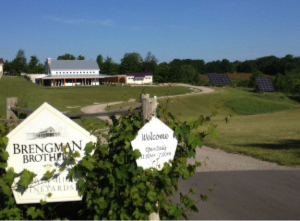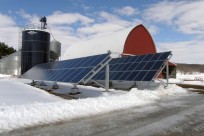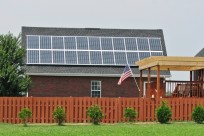Solar Power Works for Midwest Wineries
 This article is sponsored by Harvest Energy Solutions, based in Jackson, Michigan. Harvest Energy Solutions serves agribusiness customers in the Midwest with solar products, installation and solar assessments.
This article is sponsored by Harvest Energy Solutions, based in Jackson, Michigan. Harvest Energy Solutions serves agribusiness customers in the Midwest with solar products, installation and solar assessments.
The amount of solar energy reaching the earth every day is greater than all the energy used by the earth’s population in a year. Now the power of the sun is being put to work by Midwest wineries.
Last May, Brengman Brothers Crain Hill Vineyards in Traverse City, Michigan installed the largest array of solar tracking panels in Michigan. (The panels pivot to follow the arc of the sun.)

Brengeman Brothers Winery near Traverse City installed solar panels during 2013. (The panels are in the upper right corner.)
According to winery owner Robert Brengman, the solar power panels delivered about 40% more energy than what the installers predicted.
Solar energy allows Brengman to be what’s known as a ‘zero net metered” operation. In other words, Brengman either uses all the solar electricity he generates or sells any excess back to the local utility. The winery’s total solar power generation amounts to about 30,000 kilowatt hours per year (KWh), which is worth over $3,100 per year at local rates. (The average U.S. home consumes about 11,000 KWh of electricity annually.)
‘In many states, utilities must buy a certain amount of ‘clean’ energy,” Brengman says, ‘so, as strange as it may sound, our power company pays us more for the electricity than they can sell it for.”
Tom Karas of Cambridge, Minnesota, 30 miles north of the Twin Cities, conducts solar site assessments in Minnesota, Wisconsin and Upper Michigan for Harvest Energy Solutions. Karas says modern solar power is now very cost effective in the upper Midwest.
Karas describes a 20,000 kW solar system recently installed at a farm business in Michigan as an example of the current economics of solar.
According to Karas, the farmer was paying the local utility $.26 per KWh for electricity during peak daytime demand. Given the relatively high price the farmer was paying, the $70,000 solar system will pay for itself in about four and one half years.
“In order to recommend a solar system to a client, we like for the system to pay for itself in 10 years or less,” Karas says.
Anthony Leaderbrand, owner of Owen Valley Winery in Spencer, Indiana near Bloomington, turned on his 12,000 KWh solar system during October of 2013. Owen Valley is the first winery in Indiana to run primarily on solar power.
While Leaderbrand has not been operating the solar system long enough to calculate a precise return on investment, his electric bill has decreased dramatically, from around $450 a month down to about $100 a month.
“It will be interesting to see how much solar power we generate this summer, considering how well the system works on a cloudy fall day,” Leaderbrand says.
Like Brengman Winery, Owen Valley Winery has the option of selling electricity generated by the solar system back the local utility. Both wineries have so-called ‘smart meters” that record both the amount of electricity going out and coming in.
According to Karas, utilities in most states must allow people to generate electricity, but the utility can cap the size of a business’ power generation system. ‘The cap in Minnesota is 40 kW, which is generous; Michigan and Wisconsin have 20 kW caps,” Karas says.
Many utilities also allow wineries to take advantage of seasonal fluctuations in power use. Energy credits accumulated during winter can be used to pay for power during the summer when usage is normally 30% or 40% higher in the Midwest.
During the summer, solar generation is also about 30% greater than during the winter. This overproduction can be applied to a winery’s energy bill during winter months.
Solar power systems in the Midwest can generate power during the winter or when it’s cloudy. Brengman says that December and January have been the cloudiest ever in Northern Michigan. Despite the recent cloud cover, Brengman says that he’s still on track to achieve the seven year ‘payback” goal for his solar system, based on over eight months of results.
Some parts of the Midwest are better suited to solar power than others. For example, Karas says Southwest Minnesota gets 10% to 15% more sun than Door County, Wisconsin.
However, solar potential varies less from place to place than one would expect. “There’s only about 30% more sun energy reaching the ground in the desert than the cloudiest spot,” Karas said.
Sunlight duration and intensity has been extensively studied and documented in the United States. Karas says that the amount of sunlight for any location can be predicted accurately and this information is factored into the solar cost/benefit analysis. (A large version of the U.S. Department of Energy’s “Solar Resource Map” can be found at the National Renewable Energy Labs website.)
Karas says one good reason to consider solar energy now is a 30% federal tax credit which expires in 2016. (A tax credit is a dollar for reduction of federal tax owed and is therefore much more valuable than a tax deduction.) This credit, which was used both Owen Valley and Brengman, can be applied to offset federal taxes for 20 years.
Currently, it seems unlikely that Congress will renew the solar tax credit at 30% when it expires, opting instead for a smaller credit, perhaps in the range of 10% to 15%.
While the tax credit is an incentive for solar, Karas says winery owners should view solar energy as a way to control a large and uncertain expense.
‘The difference with solar is that you control the cost,” Karas says. ‘Electricity rates typically go up five percent a year and the life of a solar system is 30 years. So in 2o years, your neighbor who buys his power will be paying around two an half times today’s rate for electricity while solar power costs for the owner of a Harvest Energy solar project will never go up.”
And then there’s the public relations benefits resulting from the shiny solar panels outside a winery. According to Jim Sluyter, a consultant with the Michigan Land Institute, ‘ These renewable installations become one more draw for bringing in visitors and enhancing their experience at the winery or farm.”





1 Response
[…] Solar Power Works for Midwest Wineries […]